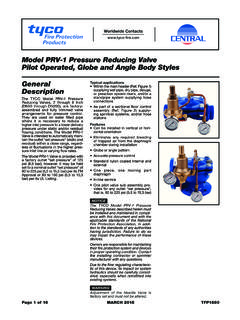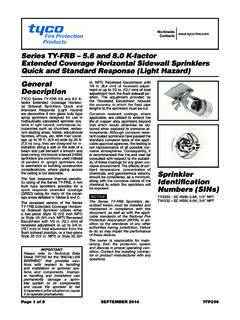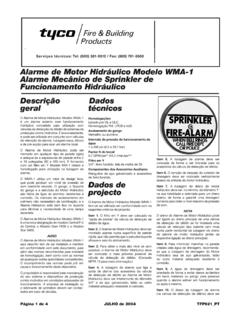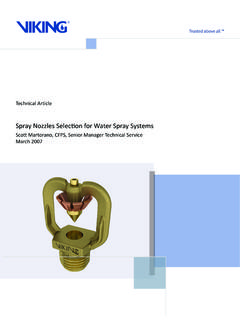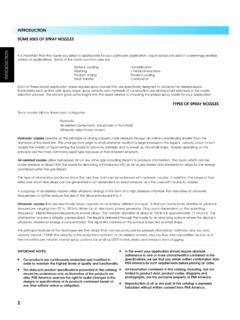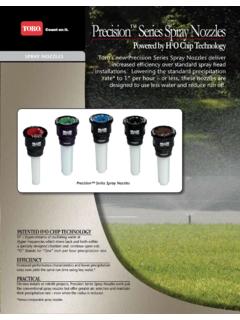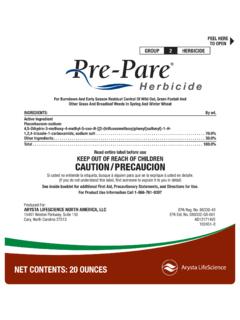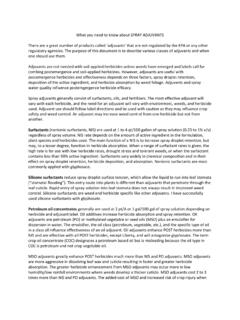Transcription of Buses de pulvérisation directionnelle Protectospray® D3 ...
1 GeneralDescriptionThe Type D3 Protectospray Nozzlesare open (non-automatic) directionalspray nozzles and they are designedfor use in water spray fixed systems forfire protection applications. They areexternal deflector type nozzles thatdischarge a uniformly filled cone ofmedium velocity water D3 Nozzles are effective in cover-ing e xpos ed v ertical, horizontal,curved, and irregular shaped surfacesin a cooling spray to prevent excessiveabsorption of heat from an external fireand possible structural damage orspread of fire to the protected equip-ment. In some applications, dependingon water design density requirements,the Type D3 Nozzles may also be usedfor fire control or Type D3 Nozzles are available ina wide variety of orifice sizes andspray angles (included angle of dis-charge) to provide versatility in systemdesign. Refer to Technical Data SheetTFP890 for information on Blow-OffPlugs that can be used for applicationswhere protection is required againstinsect infestation or accumulation ofdebris within the nozzle is recommended that the end user beconsulted with respect to the suitabilityof the materials of construction andfinish for any given corrosive environ-ment.
2 The effects of ambient tempera-ture, concentration of chemicals, andgas/chemical velocity, should be con-sidered, at a minimum, along with thecorrosive nature to which the sprin-klers may be Type D3 Protectospray nozzle isa redesignation for the Gem Type Type D3 Protectospray Nozzlesdescribed herein must be installed andmaintained in compliance with thisdocument, as well as with the applica-ble standards of the National Fire Pro-tection Association, in addition to thestandards of any other authorities hav-ing to do so mayimpair the performance of these design of individual water sprayfixed systems can vary considerably,depending on the characteristics andnature of the hazard, the basic pur-pose of the spraying system, the con-figuration of the hazard, and wind/draftconditions. Because of these vari-ations as well as the wide range ofavailable nozzle spray characteristics,the design of water spray fixed sys-tems for fire protection must only beperformed by experienced designerswho thoroughly understand the limita-tions as well as capabilities of owner is responsible for maintain-ing their fire protection system and de-vices in proper operating installing contractor or sprinklermanufacturer should be contactedwith any 1 of 6 TFP802 APRIL, 2006 Type D3 Protectospray Directional spray Nozzles, Open,Medium VelocityTechnical Services:Tel: (800) 381-9312 / Fax: (800) 791-5500 IMPORTANTA lways refer to Technical DataSheet TFP700 for the INSTALLERWARNING that provides cautionswith respect to handling and instal-lation of sprinkler systems and com-ponents.
3 Improper handling and in-stallation can permanently damagea sprinkler system or its compo-nents and cause the nozzle to fail tooperate in a fire sur 6 TFP802_FRAVRIL 2006 n ralit sLes Buses Protectospray D3 sont des Buses de pulv risation directionnelle ouvertes (non automatiques), con ues pour tre utilis es dans les syst mes fixes de pulv risation d'eau pour les applications incendie. Ce sont des Buses d flecteurs externes qui lib rent un c ne uniform ment rempli de gouttelettes d'eau vitesse Buses D3 sont efficaces pour couvrir les surfaces expos es verticales, horizontales, courbes et irr guli res gr ce une pulv ri-sation refroidissante qui emp che l'absorp-tion excessive de chaleur provenant d'un feu externe ainsi que les dommages structurels ventuels ou la propagation de l'incendie l' quipement prot g.
4 Dans certaines appli-cations, en fonction des exigences de densit d'eau, les Buses D3 peuvent galement tre utilis es pour contr ler ou teindre l' Buses D3 sont disponibles en plusieurs tailles d'orifice et angles de pulv risation (y compris l'angle de d charge) afin de fournir un syst me flexible. Reportez-vous la fiche technique TFP890 pour plus d'informations sur les bouchons anti-poussi re qui peuvent tre utilis s pour les applications o une protection contre les insectes ou l'accumu-lation de d bris dans l'orifice de la buse est est donc recommand de consulter l utili-sateur final pour savoir si ces types de mat -riaux de construction et finition sont appro-pri s un environnement corrosif donn . Les effets de la temp rature ambiante, de la concentration de produits chimiques et de la vitesse des gaz/produits chimiques doivent au moins tre pris en compte, de m me que la nature corrosive des produits chimiques auxquels les sprinkleurs seront expos buse Protectospray D3 est la nouvelle d si-gnation de la buse Gem Type installation et l entretien des Buses Protectos-pray D3 d crites dans ce document doivent tre effectu s conform ment aux indications de ce document, aux normes applicables de la National Fire Protection Association et aux normes de toute autre entit comp tente.
5 Le non-respect de ces instructions peut alt rer le fonctionnement des conception des syst mes fixes de pulv risa-tion d'eau individuels peut varier consid rable-ment, en fonction des caract ristiques et de la nature du risque, de l'objectif de base du syst me de pulv risation, de la configuration du risque et des conditions de vent. De part ces variations ainsi que les nombreuses caract ristiques de pulv risation des Buses disponibles, la concep-tion des syst mes fixes de pulv risation d'eau pour la protection incendie doit uniquement tre r alis e par des concepteurs exp riment s qui comprennent parfaitement les limites ainsi que les capacit s de ces syst propri taire des appareils et du syst me de protection incendie est charg de les conserver dans de bonnes conditions de d clenchement. Pour toute question, contactez l installateur ou le fabricant du de pulv risation directionnelle Protectospray D3 HV, ouvertes, moyenne vitesseIMPORTANTR eportez-vous section AVERTISSEMENT POUR L INSTALLATEUR de la fiche technique TFP700 qui signale les pr cautions prendre pour la manipulation et l installation des syst mes de sprinkleurs et de leurs compo-sants.
6 En effet, une manipulation et une installation incorrectes peuvent endom-mager le syst me de sprinkleurs ou ses composants, qui pourrait ne pas fonctionner en cas d incendie ou se d clencher pr matu-r natural finish, chrome plated, andlead coated bronze, as well as stain-less steel Type D3 Protectospray Noz-zles are UL and C-UL Listed, as wellas FM Working Pressure175 psi (12,1 bar).Also refer to Figure 2, Note CoefficientRefer to Table AnglesRefer to Table and MaterialRefer to Table Connection1/2 inch Characteristics(Bronze)Frame .. BronzeDeflector .. BronzeSplitter .. BronzePin .. BronzePhysical Characteristics(Stainless Steel)Frame .. ASTM A-296,Grade CF-8M ( 316 )Deflector .. Type 316 .. Type 316 .. Type 316 direct im-pingement of water spray onto all ofthe protected surface is required bythe Authority having Jurisdiction, thenozzles are to be spaced and directedso that their spray patterns will com-pletely cover the plane-of-protectionwith the minimum required averagedensity.
7 However, it is recommendedthat indoor nozzle spacing be 12 feet(3,7 m) or less and that outdoor nozzlespacing be 10 feet (3,0 m) or rundown or slippage isplanned, , exposure protection ofvessels per NFPA 15, the above rec-ommended indoor and outdoor spac-ings also used for protecting the surfacesof a vessel, for example, the nozzlesare positioned normal to and approxi-mately 2 feet (0,6 m) from the approach, in conjunction with aproperly selected spray angle, willtend to make more effective use of thespray as well as help minimize thedisturbance effects of wind/draft con-ditions on the water spray Design SprayProfiles for the nozzle spray angles of65 to 180 degrees are shown in Figure2 and apply to discharge pressures of20 to 60 psi (1,4 to 4,1 bar). Dischargepressures in excess of 60 psi (4,1 bar)will result in a decrease in coveragearea since the spray patterns tend todraw inwards at higher pressures.
8 Re-fer inquiries on higher discharge pres-sures to the Technical Services between the nozzle tip andplane-of-protection, for exposure pro-tection, are given in Table C and the axial distance from the noz-zle tip to the plane-of-protection is 3feet (0,6 m) or less, the Design SprayProfile is the same as the nominalspray angles of 65 thru 140 Pipeline pipe-line strainers per NFPA 15 are re-quired for systems utilizing nozzleswith a flow path less than 3/8 inch (9,5mm) diameter, , No. 16 thru No. 24(Ref. Table A), and for any systemwhere the water is likely to containobstructive 2 of 6 TFP802 FIGURE 1 TYPE D-3 PROTECTOSPRAY NOZZLESNOMINAL DIMENSIONSAREAWRENCHING2-1/2"(63,5 mm)(44,5 mm)1-3/4"2-1/16"(52,4 mm)1/2" NPTOF DISCHARGE) spray ANGLE(INCLUDED ANGLEAND ORIFICE SIZESTAMPED ONWRENCHINGPINDEFLECTORSPLITTERFRAMENOMI NAL MAKE-IN7/16" (11,1 mm)AREATABLE ASELECTION OF ORIFICE SIZESNO.
9 16NO. 21NO. 18NO. 28NO. 24NO. 34NO. " (12,70 mm)(11,13 mm) " (5,16 mm)(7,14 mm)(6,35 mm)(9,53 mm)(8,33 mm) " " " " " ,6103,759,043,233,125,917,3(LPM bar)ISO/SI(GPM psi)NFPAORIFICESIZEMINIMUMDIAMETERK-FACT ORTABLE BSELECTION OF spray ANGLES65 95 80 110 180 160 140 125 TechnicalDataApprovalsThe natural finish, chrome plated, andlead coated bronze, as well as stain-less steel Type D3 Protectospray Noz-zles are UL and C-UL Listed, as wellas FM Working Pressure175 psi (12,1 bar).Also refer to Figure 2, Note CoefficientRefer to Table AnglesRefer to Table and MaterialRefer to Table Connection1/2 inch Characteristics(Bronze)Frame .. BronzeDeflector .. BronzeSplitter .. BronzePin .. BronzePhysical Characteristics(Stainless Steel)Frame .. ASTM A-296,Grade CF-8M ( 316 )Deflector .. Type 316 .. Type 316 .. Type 316 direct im-pingement of water spray onto all ofthe protected surface is required bythe Authority having Jurisdiction, thenozzles are to be spaced and directedso that their spray patterns will com-pletely cover the plane-of-protectionwith the minimum required averagedensity.
10 However, it is recommendedthat indoor nozzle spacing be 12 feet(3,7 m) or less and that outdoor nozzlespacing be 10 feet (3,0 m) or rundown or slippage isplanned, , exposure protection ofvessels per NFPA 15, the above rec-ommended indoor and outdoor spac-ings also used for protecting the surfacesof a vessel, for example, the nozzlesare positioned normal to and approxi-mately 2 feet (0,6 m) from the approach, in conjunction with aproperly selected spray angle, willtend to make more effective use of thespray as well as help minimize thedisturbance effects of wind/draft con-ditions on the water spray Design SprayProfiles for the nozzle spray angles of65 to 180 degrees are shown in Figure2 and apply to discharge pressures of20 to 60 psi (1,4 to 4,1 bar). Dischargepressures in excess of 60 psi (4,1 bar)will result in a decrease in coveragearea since the spray patterns tend todraw inwards at higher pressures.

